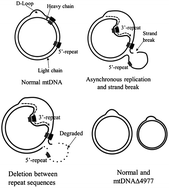A microfluidic system for fast detection of mitochondrial DNA deletion
Abstract
This study reports an integrated microfluidic system capable of automatic

* Corresponding authors
a Department of Engineering Science, National Cheng Kung University, Tainan, Taiwan
b
Institute of Oral Medicine, National Cheng Kung University, Tainan, Taiwan
E-mail:
dshieh@mail.ncku.edu.tw
Fax: +886-6-2766626
Tel: +886-6-2353535 Ext. 5410
c Department of Stomatology, National Cheng Kung University Hospital, Tainan, Taiwan
d
Department of Power Mechanical Engineering, National Tsing Hua University, Hsinchu, Taiwan
E-mail:
gwobin@pme.nthu.edu.tw
Fax: +886-3-5722840
Tel: +886-3-5715131 Ext. 33765
This study reports an integrated microfluidic system capable of automatic

 Please wait while we load your content...
Something went wrong. Try again?
Please wait while we load your content...
Something went wrong. Try again?
C. Chang, L. Chiu, P. Wang, D. Shieh and G. Lee, Lab Chip, 2011, 11, 2693 DOI: 10.1039/C1LC20317G
To request permission to reproduce material from this article, please go to the Copyright Clearance Center request page.
If you are an author contributing to an RSC publication, you do not need to request permission provided correct acknowledgement is given.
If you are the author of this article, you do not need to request permission to reproduce figures and diagrams provided correct acknowledgement is given. If you want to reproduce the whole article in a third-party publication (excluding your thesis/dissertation for which permission is not required) please go to the Copyright Clearance Center request page.
Read more about how to correctly acknowledge RSC content.
 Fetching data from CrossRef.
Fetching data from CrossRef.
This may take some time to load.
Loading related content
